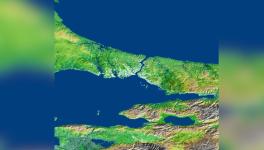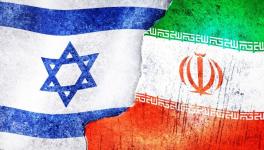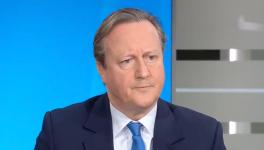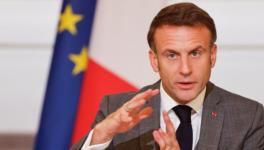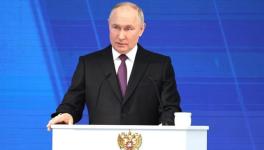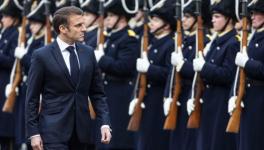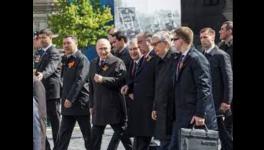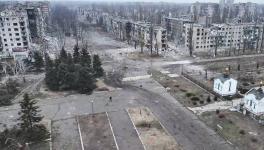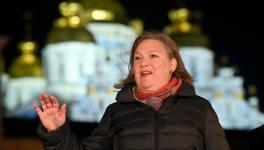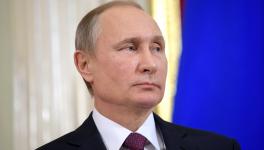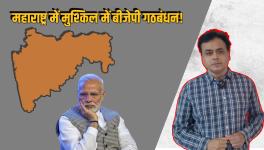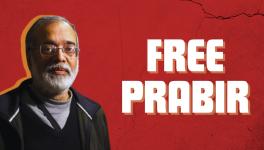An SCO Scuffle with US in Central Asia

President Putin with then Kyrgyz President Askar Akayev during inauguration ceremony at Russian airbase at Kant, Oct. 23, 2003
It may seem unbelievable today when the Russian President Vladimir Putin is insistently holding back on congratulating Joe Biden on his magnificent victory even twenty-five days after the November 3 presidential election, that he was the first foreign dignitary to call up then US President George W. Bush when the 9/11 terrorist attacks took place in New York and Washington in 2001.
Putin anticipated that Bush would have no option but to order retaliation and that the theatre would almost certainly be Afghanistan. Simply put, Putin decided to be on the ‘right side of history’. The Kremlin assessed that golden opportunity was opening up for Moscow to work shoulder to shoulder with the US on international security that could possibly elevate the Russian-American relationship to a qualitatively new level.
The Shanghai Cooperation Organisation (SCO) was formed hardly three months earlier but for Moscow, the foreign policy priority continued to be the relations with the US. Curiously, at his very first press conference at the Kremlin on 18th July 2001after being elected president, Putin had made an astounding proposal that his country should be allowed to join NATO or the alliance should be disbanded and replaced by a new body that includes all of Europe and Russia.
Putin had just returned after a visit to China where he signed a comprehensive friendship treaty with Chinese President Jiang Zemin, which had raised prospects for a joint Sino-Russian stance against US plans to develop a missile shield and scrap the Anti-Ballistic Missile treaty. But at the Kremlin press conference, Putin ruled out any plans of coordinating with China. “We have enough means to respond to any changes ourselves,” he said.
In Putin’s words, “There is no more Warsaw Pact, no more Soviet Union, but NATO continues to exist and develop. We (Russia) do not see it as an enemy. We do not see a tragedy in its existence, but we also see no need for it.” Putin elaborated that NATO’s expansion into Eastern Europe creates “different levels of security on the continent … which does not correspond to today’s realities and is not caused by any political or military necessity.”
Thus, in the downstream of the 9/11 attacks in the US, Putin not only offered Russia’s helping hand to Bush but ordered the Russian intelligence to share its vast archives on Afghanistan with their American counterparts for undertaking any military operations in that country.
Putin also personally intervened with the Central Asian leaderships to allow the Pentagon to use bases in the region for operations in Afghanistan. There is some evidence, though, that the Americans led the Russians to believe that their need of the Central Asian bases would be purely temporary.
But, as it happened, as of late January 2002, there were already somewhere around 4,000 US troops in Afghanistan, of which about 3,000 were at Kandahar, and about 500 were stationed at Bagram, where the runway began to be repaired by US, Italian, and Polish military personnel.
Soon it emerged that the US sequestered the Afghan war from any form of Russian participation. The trust deficit widened when following the US invasion of Iraq and the Rose Revolution in Georgia in 2003, another colour revolution took place in Ukraine in 2004, and in February-March 2005, in a familiar pattern, following the parliamentary election in Kyrgyzstan, US-backed revolutionaries alleged corruption and authoritarianism by the pro-Russian president Askar Akayev (a Soviet physicist and academician), his family and supporters, and forced him to flee the country and go into exile in Moscow.
Conceivably, Russia and China shared nearly identical views that colour revolutions were the product of machinations by the US and its Western allies and posed a vital threat to their public and national security. But what probably set alarm bells ringing was the bloody uprising in Andijan in the Fergana Valley in May 2005. Anywhere upto 1500 people might have been killed as Uzbek troops crushed the rebellion.
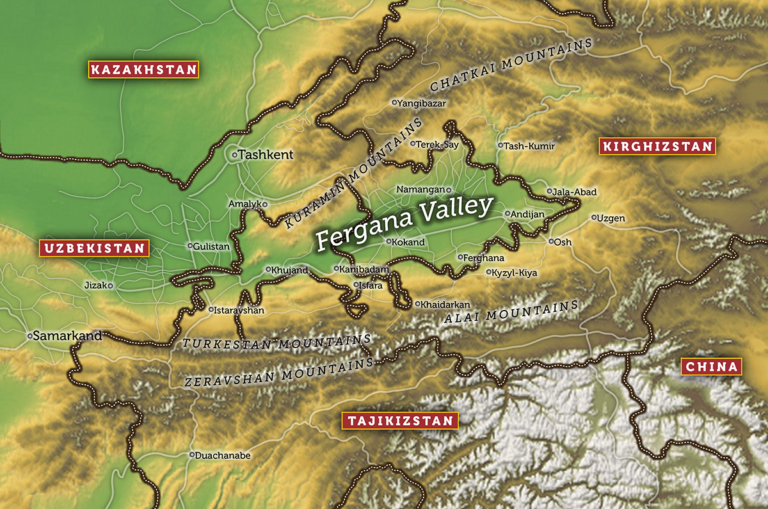
The Uzbek government at first blamed the Islamic Movement of Uzbekistan for the uprising. But as it turned out, the protesters were members of Hizb ut-Tahrir, the shadowy Islamist organisation based in UK and other European capitals. Unsurprisingly, the needle of suspicion turned toward the large US/NATO intelligence set-up in Afghanistan.
Against this backdrop, the SSCO summit meeting on July 5 in Almaty, Kazakhstan, took an unprecedented step to call on the US to set a deadline for the removal of its military bases in Central Asia. The statement said, “Considering that the active phase of the military anti-terrorist operation in Afghanistan has finished, member states … consider it essential that the relevant participants in the anti-terrorist coalition set deadlines for the temporary use” of military bases in the region.
Russia nor China projected this as a collective decision by the SCO. Sergei Prikhodko, an aide to President Putin softened the blow by qualifying that it was not a demand for the US to withdraw immediately, but it was “important for the SCO members to know when (US) troops will go home”.
But three days after the SCO summit, the lower house of the Russian parliament ratified a 15-year bilateral agreement between Russia and Kyrgyzstan to double the number of Russian troops at its airbase at Kant, east of Bishkek. Russia also announced separately plans to deploy more combat aircraft to Kant air base, which was within two minutes flying time from the US base at Manas, which was garrisoned by hundreds of American troops.
The SCO declaration in 2005 was the first signal that Russia and China were taking tentative steps to challenge the US military presence in Central Asia. While all the member-states of the SCO had initially endorsed the US invasion of Afghanistan, the American intentions were no longer accepted at face value as a war to eradicate terrorism.
The impression began to grow that the US had strategic ambitions to deploy military forces into the Central Asian territories and attempt to assert dominance over the resource-rich area as well as to exert a continuous threat against countries in the region, including Russia, China and Iran.
Evidently, Moscow and Beijing began viewing the SCO as a platform to shore up their influence in the Central Asian region. Moscow began seeking a closer relationship with China as a counterweight to the US. Sergei Markedonov, a researcher at Russia’s Institute of Political and Military Analysis, told the Moscow-based RIA Novosti newspaper that the political unrest in Central Asia showed that Russia, in cooperation with China, needed to function as “a regional policeman”.
Meanwhile, China also had become a stakeholder in Central Asia with definite strategic interests. China had financed a network of pipelines in Central Asia to Xinjiang province. China also feared that US predominance in the region, or US-inspired political instability, could disrupt its plans, as well as potentially encourage ethnic unrest in Xinjiang.
Significantly, the SCO call to wind down the US military bases in Central Asia came just after meetings between Putin and the Chinese President Hu Jintao, who visited Moscow from June 30 to July 3, 2005. Interestingly, at the SCO summit on July 5, the Central Asian countries lined up with Moscow and Beijing’s rhetoric against “unilateralism”— a codeword for US global hegemony. Then Kazakh President Nursultan Nazarbayev declared: “There should be no place for interference in the internal affairs of sovereign states”.
The Uzbek president Islam Karimov said pro-Western forces “hijack stability and impose their model of development” on the region. To show its commitment to the SCO line, the Uzbek government issued a statement on July 7 insisting that flights from the US air base in Karshi-Khanabad be strictly confined to operations over northern Afghanistan.
But the US didn’t give in easily. On July 14, the chairman of US Joint Chiefs of Staff, Richard Myers openly accused China and Russia of “trying to bully” the Central Asian states into calling for the closure of the American bases.
A week later, US Secretary of Defence Donald Rumsfeld flew into Kyrgyzstan and rapidly extracted agreements for the continuation of the airbase in the country. On July 12, the Bush administration threatened Uzbekistan with “a serious, credible and independent” international inquiry into the Andijan uprising.
However, the US vacated its base at Karshi-Khanabad in southeastern Uzbekistan in November 2005, while the Kyrgyz government allowed the US to use the Transit Center at Manas (formerly Manas Air Base) near Bishkek till the expiry of the lease in 2014.
Nonetheless, in later years, when the US and NATO forces’ supply routes through Pakistan came under pressure as the US-Pakistan relations began deteriorating, Moscow stepped in to provide an alternate route via Russian and Central Asian territories — on a payment basis, of course — to deliver vital fuel, food, hardware and other logistic supplies for the troops deployed in Afghanistan.

The bi-directional system of air, land and sea supply routes known as the Northern Distribution Network (NDN) was established in mid-2008. Originally only non-lethal resources were allowed on the NDN. In July 2009, however, shortly before a visit by President Barack Obama to Moscow, Russian authorities announced that US troops and weapons could use the country’s airspace to reach Afghanistan.
However, in May 2015, following the developments in Ukraine and western sanctions against Moscow, this key military transport corridor which allowed NATO to deliver military supplies to Afghanistan through the Russian territory was closed.
Some conclusions can be drawn from the whole episode. The 2005 SCO summit drew a red line for the US, but it was more of a cautionary tale rather than an act of belligerence. Importantly, the Sino-Russian partnership had acquired maturity and the SCO gained traction.
Nonetheless, Russia and China did not push the envelope, and took care that the tempo of US-led war on terror in Afghanistan, which was also in their interests, was unaffected. Fundamentally, Russia and China attributed much higher importance to the respective relationship with the US than with each other.
Above all, Russia and China were careful not to cast the SCO as an anti-western “NATO of the East”. Instead, they continued to project the SCO as an open, inclusive regional forum. Interestingly, the SCO summit in 2005 also admitted India, Pakistan and Iran as observers.
Indeed, the entire episode in 2005 might have raised the US’ comfort level with the SCO. While continuing to voice concerns over the SCO’s potential to exclude the US, American officials also began suggesting in 2006 and 2008 that the organisation could provide Central Asian states a beneficial tool for cooperation and an alternative to domination by Russia in areas such as energy.
Some US analysts even predicted that India and Pakistan’s eventual membership would prevent SCO’s future potential as an anti-Western or anti-American actor challenging American interests in a coordinated way. Of course, it turned out to be an accurate prediction.
READ ALSO: Return of Great Game in Post-Soviet Central Asia, Nov. 22, 2020; China, Russia reinvent their moorings in Central Asia, Nov. 24, 2020.
Get the latest reports & analysis with people's perspective on Protests, movements & deep analytical videos, discussions of the current affairs in your Telegram app. Subscribe to NewsClick's Telegram channel & get Real-Time updates on stories, as they get published on our website.









